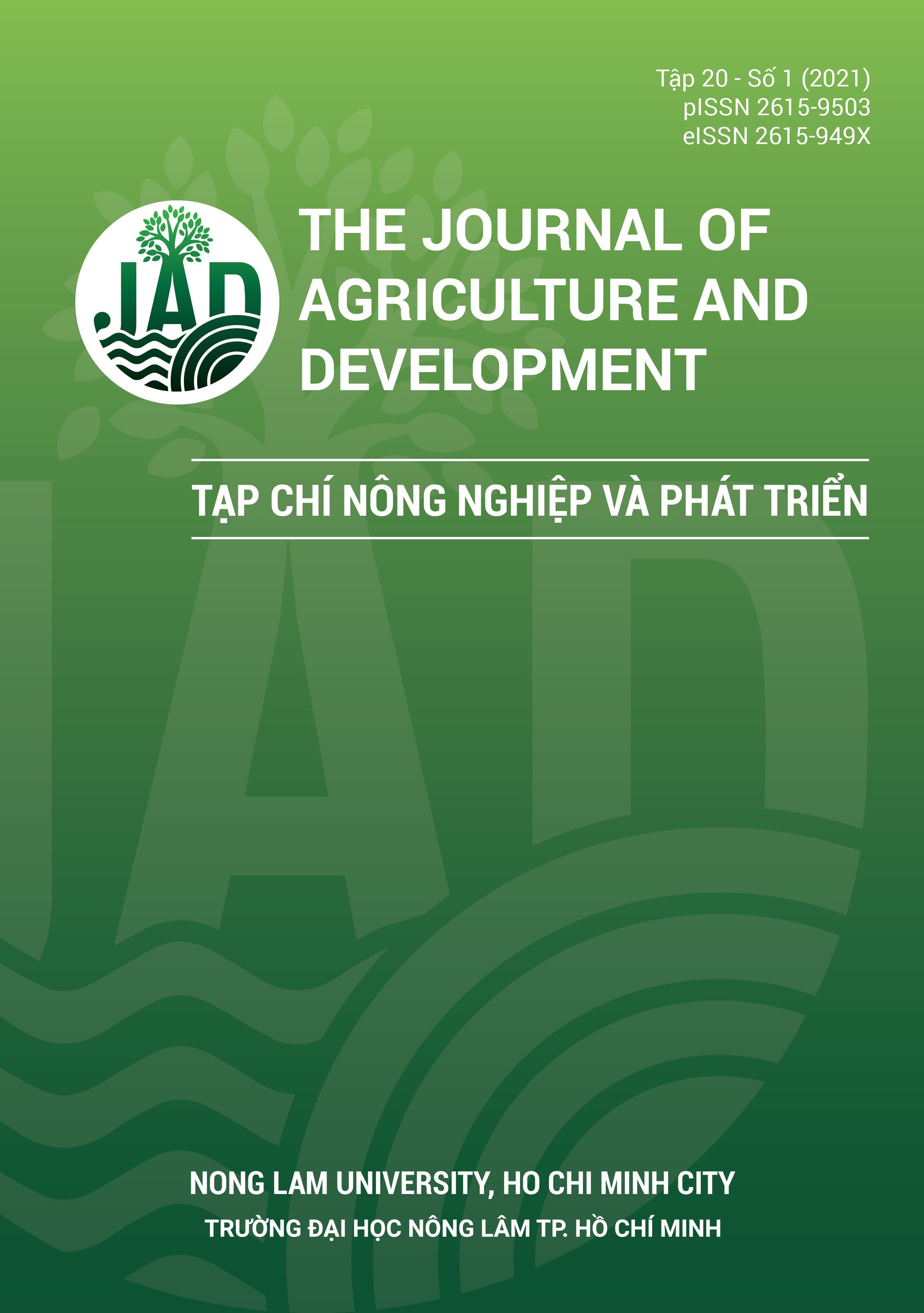The effectiveness of Saccharomyces cerevisiaein inhibiting aflatoxin production andreducing the harmful effects of aflatoxin in ducklings
Main Article Content
Abstract
Sacharomyces cerevisiae isolates were obtained from baker’s yeast, soil, fruit and identified with PCR. Twenty seven isolates of S. cerevisiae were screened for capacity of inhibition of aflatoxin production of Aspergillus flavus (A. flavus) on coconut extract agar media (CEA). The results showed that the co-culture method of S. cerevisiae isolates and aflatoxin producing A. flavus on CEA medium could be used for screening the strains that are able to antagonize aflatoxin-producing A. flavus. Onground corn medium, with the rate of 104 aflatoxin-producing A. flavus spores and 108S. cerevisiaeyeast cells/g, S. cerevisiaewas able to reduce the amount of aflatoxin produced by A. flavusin corn. In an in vivo experiment, it was found that addition of 108 cells of S. cerevisiaeto one kg of duck feed contaminatedwith 300 ppb aflatoxin from 1 to 10 days of age reduced adverseeffects of aflatoxin on the liver and kidneys of ducks.
Article Details
References
Çelýk, K., Denlý, M., & Savas, T. (2003). Reduction of toxic effects of aflatoxin B1 by using baker yeast (Saccharomyces cerevisiae) in growing broiler chicks diets. Revista Brasileira de Zootecnia 32(3), 615-619.
Kusumaningtyas, E., Widiastuti, R., & Maryam R. (2006). Reduction of aflatoxin B1 in chicken feed by using Saccharomyces cerevisiae, Rhizopus oligosporus and their combination. Mycopathologia 162(4), 307-311. https://doi.org/10.1007/s11046-006-0047-4
Le, P. A. ( 2002). Effects of some substances capable of adsorbing Aflatoxin in super meat duck feeding diets (Unpublished Doctoral Dissertation). Nong Lam University, Ho Chi Minh City, Vietnam.
Matur, E., Ergul, E., Akyazi, I., Eraslan, E., & Cirakli, Z. T. (2010). The effects of Saccharomyces cerevisiae extract on the weight of some organs, liver, and pancreatic digestive enzyme activity in breeder hens fed diets contaminated with aflatoxins. Poultry Science 89(10), 2213-2220. https://doi.org/10.3382/ps.2010-00821
Nguyen, N. H. (2006). Bacillus subtilis possibly used for aflatoxin control. Proceedings of International workshop on Biotechnology in Agriculture (75-77). Ho Chi Minh City, Vietnam: Nong Lam University. 75-77.
Pinheiro, R. E. E., Rodrigues, A. M. D., Lima, C. E., Santos, J. T. O., Pereyra, C. M., Torres, A. M., Cavaglieri, L. R., Lopes, J. B., & Muratori, M. C. S. (2020). Saccharomyces cerevisiae as a probiotic agent and a possible aflatoxin B1 adsorbent in simulated fish intestinal tract conditions. Arquivo Brasileiro de Medicina Vet- erinária e Zootecnia 72(3), 862-870.
Pizzolitto, R. P., Armando, M. R., Salvano, M. A., Dalcero, A. M., & Rosa, C. A. (2013). Evaluation of Saccharomyces cerevisiae as an antiaflatoxicogenic. Poultry Science 92(6), 1655-1663. https://doi.org/10.3382/ps.2012-02846
Sabaté, J., Guillamon, J. M., & Cano, J. (2000). PCR differentiation of Saccharomyces cerevisiae from Saccharomyces bayanus/Saccharomyces pastorianus using specific primers. FEMS Microbiology Letters 193(2), 255-259. https://doi.org/10.1111/j.1574-6968.2000.tb09433.x
Stanley, V. G., Ojo, R., Woldesenbet, S., Hutchinson, D. H., & Kubena, L. F. (1993). The use of Saccharomyces cerevisiae to suppress the effects of aflatoxicosis in broiler chicks. Poultry Science 72(10), 1867-1872. https://doi.org/10.3382/ps.0721867
Zaghini, A., Martelli, G., Roncada, P., Simioli, M., & Rizzi, L. (2005). Mannanoligosaccharides and aflatoxin B1 in feed for laying hens: Effects on egg quality, aflatoxins B1 and M1 residues in eggs, and aflatoxin B1 levels in liver. Poultry Science 84(6), 825-832. https://doi.org/10.1093/ps/84.6.825








